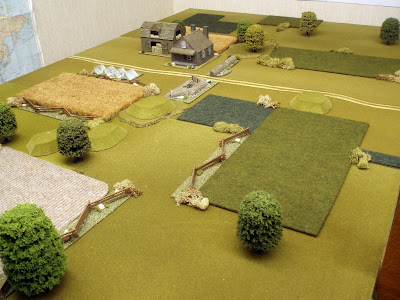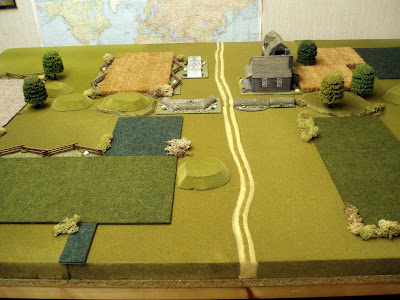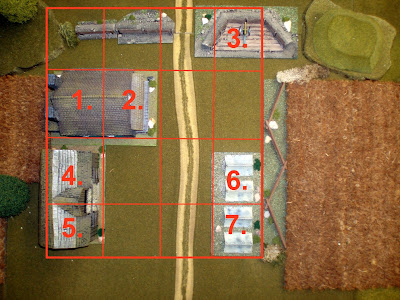Dawn is about to break
 A Union force comprising two regiments of foot, and a section of artillery (one 12pdr Napoleon) is camped around the gulley dominating a major road. They have been told to expect a Confederate attack but they are not expecting it to be so soon – they have placed a number of outposts (4) to act as pickets.
A Union force comprising two regiments of foot, and a section of artillery (one 12pdr Napoleon) is camped around the gulley dominating a major road. They have been told to expect a Confederate attack but they are not expecting it to be so soon – they have placed a number of outposts (4) to act as pickets.
 The Confederate force comprising 3 regiments of foot moves onto the table in two columns from east and south west in period one. Dice for which regiment is in which column but there has to be a minimum of one regiment in each.
The Confederate force comprising 3 regiments of foot moves onto the table in two columns from east and south west in period one. Dice for which regiment is in which column but there has to be a minimum of one regiment in each.
All movement is at half move distance only, because of the darkness.
The Confederate commander throws one dice for each half of his force to determine in which period (1 to 6) the nearest outpost sees them (2 outposts per column).
If a Confederate column can reach the camp before any of the outposts can see them (using half distance movement as before), they are considered captured and the alarm is triggered when the force touches the edge of the camp. Otherwise, the outpost starts moving towards the camp (infantry rate) on the turn indicated.
Once an outpost sees the enemy approaching, or the Confederates reach the camp, it may be considered to be light enough for all units to move at normal speed.
The outpost must reach the camp area before any movement may begin in the camp. From the point at which the outpost reaches the camp, the warning spreads inwards through the camp at the rate of 10 cm’s per period.
All movement within the camp area is half speed.
Union forces units are laid out in the camp as shown in the following. The grid is 10cm square.
 Legend:
Legend:
1. 3 stands of infantry – 8th Ohio
2. Artillery crew
3. The gun (deployed)
4. 2 stands of infantry – 8th Ohio
5. Artillery limber
6. 3 stands of infantry – 67th Ohio
7. 2 stands of infantry – 67th Ohio
As each unit is alerted, that is, when it comes into the gradually expanding arc of ten cm’s a period, it throws two dice which will decide its action.
I'll describe these actions in the next post.
Credits: This scenario is of course a re-working of Charles Grant's excellent "Dawn Attack" Teaser [click here] from the October '78 issue of Battle magazine.
 A Union force comprising two regiments of foot, and a section of artillery (one 12pdr Napoleon) is camped around the gulley dominating a major road. They have been told to expect a Confederate attack but they are not expecting it to be so soon – they have placed a number of outposts (4) to act as pickets.
A Union force comprising two regiments of foot, and a section of artillery (one 12pdr Napoleon) is camped around the gulley dominating a major road. They have been told to expect a Confederate attack but they are not expecting it to be so soon – they have placed a number of outposts (4) to act as pickets. The Confederate force comprising 3 regiments of foot moves onto the table in two columns from east and south west in period one. Dice for which regiment is in which column but there has to be a minimum of one regiment in each.
The Confederate force comprising 3 regiments of foot moves onto the table in two columns from east and south west in period one. Dice for which regiment is in which column but there has to be a minimum of one regiment in each.All movement is at half move distance only, because of the darkness.
The Confederate commander throws one dice for each half of his force to determine in which period (1 to 6) the nearest outpost sees them (2 outposts per column).
If a Confederate column can reach the camp before any of the outposts can see them (using half distance movement as before), they are considered captured and the alarm is triggered when the force touches the edge of the camp. Otherwise, the outpost starts moving towards the camp (infantry rate) on the turn indicated.
Once an outpost sees the enemy approaching, or the Confederates reach the camp, it may be considered to be light enough for all units to move at normal speed.
The outpost must reach the camp area before any movement may begin in the camp. From the point at which the outpost reaches the camp, the warning spreads inwards through the camp at the rate of 10 cm’s per period.
All movement within the camp area is half speed.
Union forces units are laid out in the camp as shown in the following. The grid is 10cm square.
 Legend:
Legend:1. 3 stands of infantry – 8th Ohio
2. Artillery crew
3. The gun (deployed)
4. 2 stands of infantry – 8th Ohio
5. Artillery limber
6. 3 stands of infantry – 67th Ohio
7. 2 stands of infantry – 67th Ohio
As each unit is alerted, that is, when it comes into the gradually expanding arc of ten cm’s a period, it throws two dice which will decide its action.
I'll describe these actions in the next post.
Credits: This scenario is of course a re-working of Charles Grant's excellent "Dawn Attack" Teaser [click here] from the October '78 issue of Battle magazine.
I look forward to further developments. I'm sure the Federals will pull it out of the bag.
ReplyDeleteNice looking battlefield
ReplyDeleteInteresting. Wouldn't the piquets fire their muskets to alert the camp when they spot the enemy? Or is theory powder perhaps damp after a foggy night? Looks promising.
ReplyDeleteI think I played this one in the late 70's/early 80's against my next door neighbour (the guy that really pointed me towards wargames) with my Airfix soldiers! Possibly my first ever game..cool or what!
ReplyDeleteMatt
Ross Mac - interesting question yourself - do you know I hadn't even thought of that and neither had Charles Grant as the possibility is not even discussed. When I think of it it would be the first thing you do!
ReplyDeleteI'm going to play it though that they don't have the facility, either because the powder is damp, or they've been told not to for some reason....